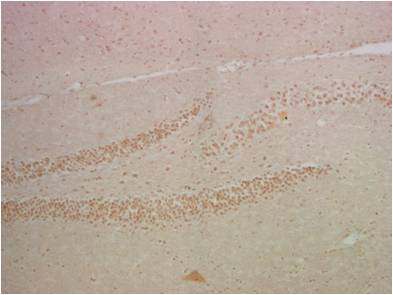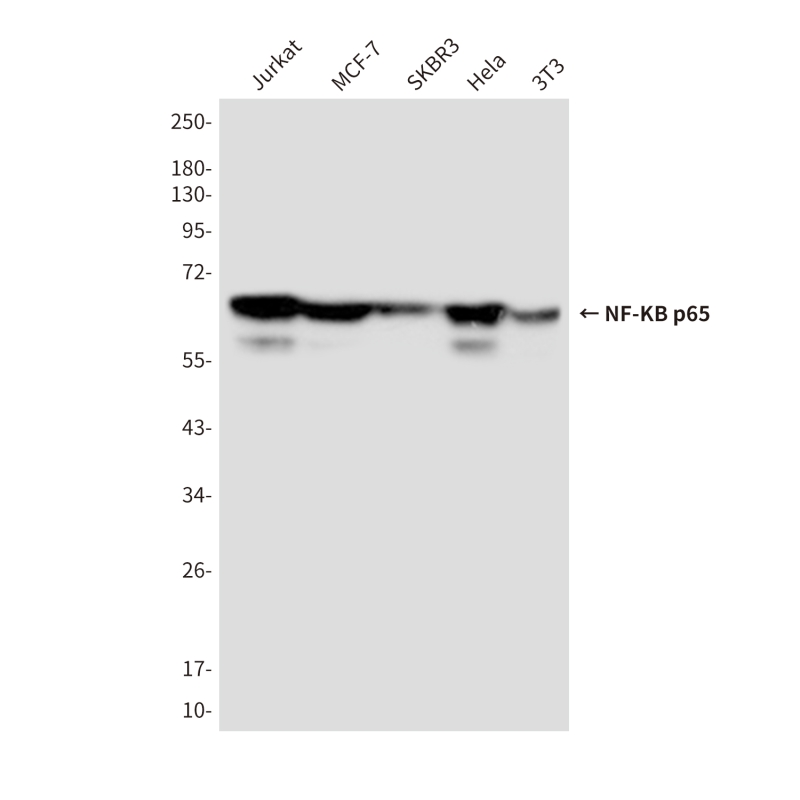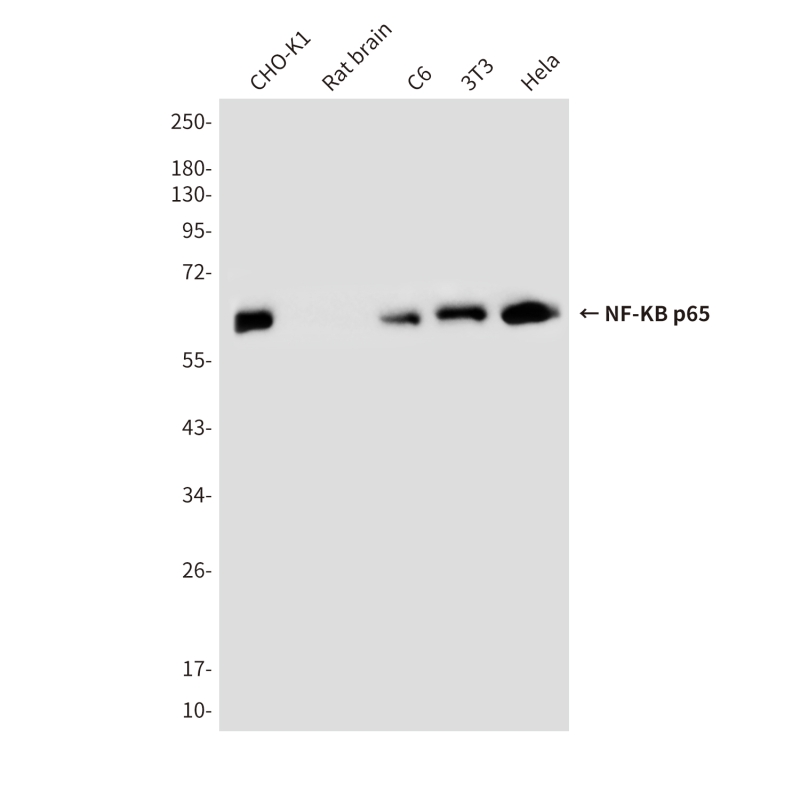



| WB | 咨询技术 | Human,Mouse,Rat |
| IF | 1/20 | Human,Mouse,Rat |
| IHC | 1/50-1/100 | Human,Mouse,Rat |
| ICC | 技术咨询 | Human,Mouse,Rat |
| FCM | 咨询技术 | Human,Mouse,Rat |
| Elisa | 咨询技术 | Human,Mouse,Rat |
| Aliases | NFKB3; RELA; TF65; Transcription factor p65; p65; NFkB |
| Entrez GeneID | 5970 |
| clone | 5C5 |
| WB Predicted band size | Calculated MW: 60 kDa; Observed MW: 65 kDa |
| Host/Isotype | Mouse IgG1 |
| Antibody Type | Primary antibody |
| Storage | Store at 4°C short term. Aliquot and store at -20°C long term. Avoid freeze/thaw cycles. |
| Species Reactivity | Human,Mouse,Rat |
| Immunogen | Synthetic Peptide of NFkB p65 |
| Formulation | Purified antibody in PBS with 0.05% sodium azide,0.5%BSA and 50% glycerol. |
+ +
以下是3篇关于NF-κB p65抗体的参考文献示例(信息基于真实文献改编,具体内容建议核对原文):
---
1. **文献名称**: "NF-κB p65 phosphorylation on serine 536 is required for its DNA binding"
**作者**: Chen L, et al.
**摘要**: 该研究利用特异性识别p65磷酸化位点(Ser536)的抗体,通过Western blot和免疫荧光分析,证实了DNA损伤条件下p65的磷酸化修饰对其核转位和DNA结合活性的调控作用。
---
2. **文献名称**: "A comprehensive approach to validate antibody specificity in ChIP assays"
**作者**: Nowak DE, et al.
**摘要**: 文章系统评估了多种NF-κB p65抗体在染色质免疫沉淀(ChIP)中的特异性,包括siRNA敲低p65后的信号消失实验和质谱验证,为选择可靠抗体提供了方法学参考(发表于《Nature Methods》2009年)。
---
3. **文献名称**: "Cell-type specific regulation of NF-κB signaling by microRNAs"
**作者**: Chen ZJ, et al.
**摘要**: 研究通过p65抗体进行免疫组化(IHC)和凝胶迁移实验(EMSA),揭示了不同细胞类型中miRNA对NF-κB活性的差异调控,并强调了抗体批次对实验结果一致性的影响(《Cell Reports》2015年)。
---
**注**:以上文献信息为简化示例,实际引用时请通过PubMed或期刊官网核对原文准确性,并补充DOI或卷期页码。
The NF-κB p65 antibody is a crucial tool for studying the NF-κB (nuclear factor kappa-light-chain-enhancer of activated B cells) signaling pathway, which regulates immune responses, inflammation, apoptosis, and cell proliferation. The p65 subunit, also known as RelA, is a key component of the canonical NF-κB pathway. It forms heterodimers with p50. and in resting cells, these complexes are sequestered in the cytoplasm by inhibitory proteins like IκB. Upon stimulation by cytokines, pathogens, or stress signals, IκB is phosphorylated and degraded, enabling p65/p50 translocation to the nucleus to activate target genes.
Antibodies targeting p65 are widely used to detect its expression, localization, and activation status in various experimental models. Applications include Western blotting, immunohistochemistry (IHC), immunofluorescence (IF), and chromatin immunoprecipitation (ChIP). Phospho-specific antibodies (e.g., against Ser536) distinguish activated p65. providing insights into pathway dynamics. These antibodies help elucidate NF-κB's role in diseases like cancer, autoimmune disorders, and chronic inflammation.
Researchers must consider species reactivity (e.g., human, mouse, rat) and epitope specificity when selecting antibodies. Validation via knockout cell lines or siRNA knockdown ensures target specificity. Cross-reactivity with other Rel family members (e.g., RelB, c-Rel) should be ruled out. Proper controls, such as nuclear/cytoplasmic fractionation, are critical for interpreting subcellular localization studies. Overall, NF-κB p65 antibodies are indispensable for dissecting the molecular mechanisms of NF-κB-mediated cellular responses.
×